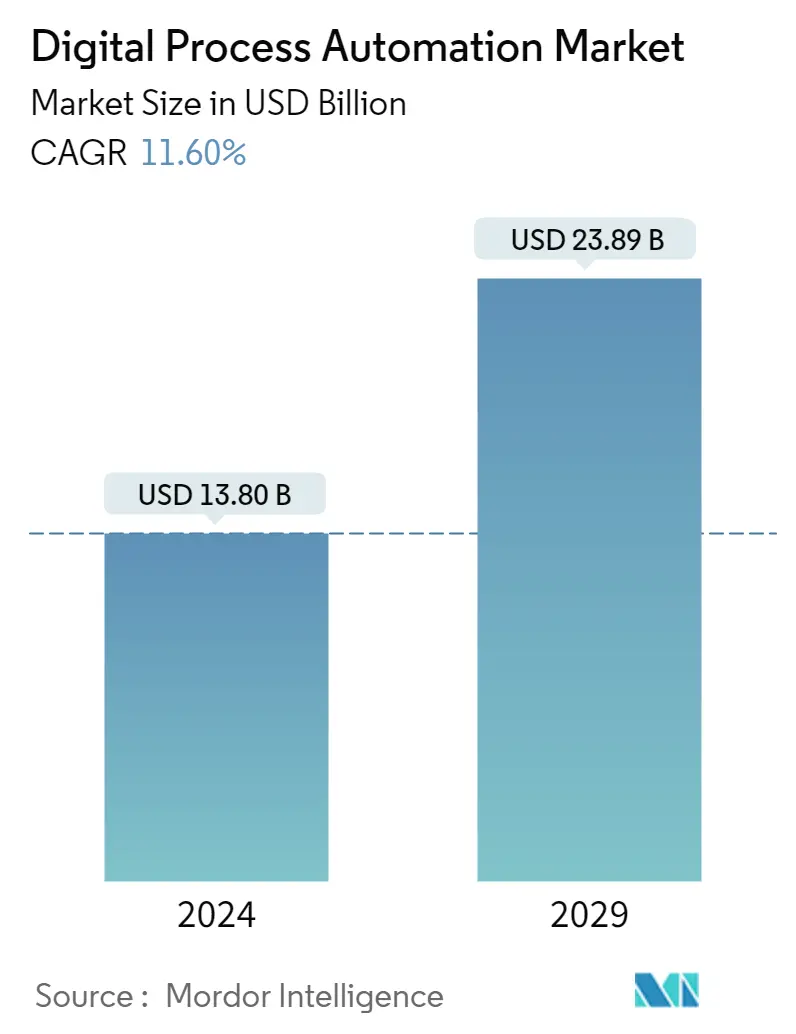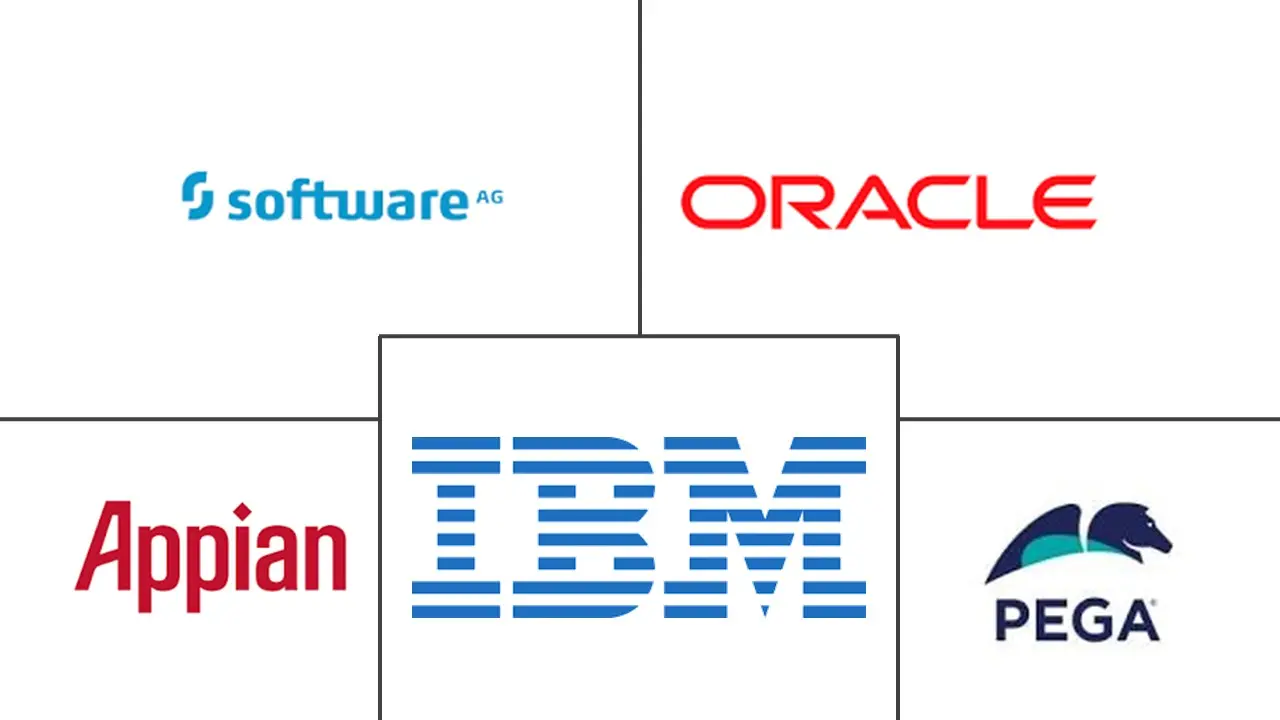Market Size of Digital Process Automation Industry

| Study Period | 2019 - 2029 |
| Market Size (2024) | USD 13.80 Billion |
| Market Size (2029) | USD 23.89 Billion |
| CAGR (2024 - 2029) | 11.60 % |
| Fastest Growing Market | Asia Pacific |
| Largest Market | North America |
Major Players
*Disclaimer: Major Players sorted in no particular order |
Digital Process Automation Market Analysis
The Digital Process Automation Market size is estimated at USD 13.80 billion in 2024, and is expected to reach USD 23.89 billion by 2029, growing at a CAGR of 11.60% during the forecast period (2024-2029).
As new technologies are trending and accelerating, merging the virtual and physical worlds creates new business models. Manufacturers are introducing new business models under which they sell digital services and products, such as digital twins.
- Improving operational effectiveness and simplifying business processes are top priorities for organizations across all industries. According to inference, this emphasis on efficiency drives the demand for DPA solutions. By automating and optimizing manual and repetitive tasks, firms may lower errors, get rid of bottlenecks, and boost process efficiency. Organizations can achieve faster turn-around times, increased productivity, and cost savings by automating workflows and standardizing processes. The need for DPA solutions is anticipated to increase as companies look to enhance client experiences, drive operational excellence, and maintain their competitiveness in a changing market.
- Another significant market driver for DPA solutions is organizations' continual digital transformation path. According to inference, businesses are embracing digital technology at a faster rate to revolutionize their operations, improve consumer experiences, and gain a competitive advantage. By enabling organizations to digitize and automate their fundamental business activities, DPA plays a crucial part in this shift. DPA solutions enable organizations to achieve end-to-end process automation and agility by automating manual operations, linking systems and applications, and offering real-time visibility into process performance. The need for DPA is fueled by organizations' need to utilize digital technology and attain operational digital maturity.
- Legacy systems and complex IT environments can pose a significant restraint on the adoption of DPA solutions. Inference suggests that many organizations have existing systems, applications, and technologies in place that are not designed to easily integrate with DPA platforms. These legacy systems may lack the necessary APIs (Application Programming Interfaces) or modern architecture to seamlessly connect with DPA solutions, making integration challenging and time-consuming. Additionally, organizations may have heavily customized or proprietary software that is not easily compatible with off-the-shelf DPA tools.
- While the pandemic drove increased adoption of DPA solutions in many sectors, it also introduced budget constraints and shifting priorities for some organizations. Inference suggests that businesses heavily impacted by the pandemic may have diverted resources to address immediate challenges, such as cost-cutting measures or focusing on essential operations. This could have slowed down the adoption of DPA solutions or led to delays in planned projects. In addition, organizations that experienced financial difficulties may have limited budgets for investing in new technologies, including DPA. There has also been an impact of the Russia-Ukraine war on the overall packaging ecosystem.
Digital Process Automation Industry Segmentation
Digital process automation uses digital technology to perform a process or accomplish a workflow or function. The main drivers for the market include the integration of Artificial Intelligence (AI) and Machine Learning (ML) technologies. Businesses worldwide have relied on business process management (BPM) to enhance and manage the back-end activities efficiently and on the processes, such as retail lending, customer onboarding, customer support, etc.
The digital process automation market is segmented by component (solution, service), deployment (on-demand, on-premises), organization size (small- and medium-sized enterprises, large enterprises), end user (banking, financial services, and insurance (BFSI), manufacturing, IT and telecommunication, aerospace and defense, healthcare, retail, and consumer goods), and geography (North America, Europe, Asia-Pacific, Latin America, and Middle East & Africa). The report offers market forecasts and size in value (USD) for all the above segments.
| By Component | |
| Solution | |
| Service |
| By Deployment | |
| On-demand | |
| On-premise |
| By Organization Size | |
| Small- and Medium-sized Enterprises | |
| Large Enterprises |
| By End User | |
| Banking, Financial Services, and Insurance (BFSI) | |
| Manufacturing | |
| IT and Telecommunication | |
| Aerospace and Defense | |
| Healthcare | |
| Retail and Consumer Goods | |
| Other End Users |
| Geography | |
| North America | |
| Europe | |
| Asia Pacific | |
| Latin America | |
| Middle East and Africa |
Digital Process Automation Market Size Summary
The digital process automation (DPA) market is poised for significant growth as organizations increasingly prioritize operational efficiency and the simplification of business processes. This demand is driven by the need to automate and optimize manual tasks, which helps reduce errors, eliminate bottlenecks, and enhance process efficiency. As companies strive to improve client experiences and maintain competitiveness, DPA solutions become essential. The ongoing digital transformation journey further propels the adoption of DPA, as businesses seek to digitize and automate core activities to gain a competitive edge. However, challenges such as legacy systems and complex IT environments can hinder the seamless integration of DPA solutions, posing a restraint on market growth.
In North America, the DPA market is expected to see substantial contributions due to the presence of numerous vendors and the region's focus on advanced sensing technologies. The United States, in particular, is experiencing growth driven by improved technology and streamlined global supply chains. Strategic partnerships and technological innovations, such as those between Sigma Solve and Liferay DXP, are enhancing economic opportunities for manufacturers. The market is characterized by fragmentation, with key players like IBM Corporation, Pegasystems Inc., and Oracle Corporation leading through continuous product launches and technological advancements. Recent developments, including collaborations and updates in automation tools, underscore the dynamic nature of the DPA market, as organizations seek to leverage automation for increased operational efficiency and innovation.
Digital Process Automation Market Size - Table of Contents
-
1. MARKET DYNAMICS
-
1.1 Market Overview
-
1.2 Industry Attractiveness - Porter's Five Forces Analysis
-
1.2.1 Threat of New Entrants
-
1.2.2 Bargaining Power of Consumers
-
1.2.3 Bargaining Power of Suppliers
-
1.2.4 Threat of Substitute Products
-
1.2.5 Intensity of Competitive Rivalry
-
-
1.3 Assessment of the Impact of COVID-19 on the Market
-
1.4 Market Drivers
-
1.4.1 Increase Demand of Automating Business Process for Efficient Back-end process
-
1.4.2 Increase Adoption of Low Code Automation for Greater Accessibility
-
-
1.5 Market Restraints
-
1.5.1 Lack of Skilled Workforce
-
-
-
2. MARKET SEGMENTATION
-
2.1 By Component
-
2.1.1 Solution
-
2.1.2 Service
-
-
2.2 By Deployment
-
2.2.1 On-demand
-
2.2.2 On-premise
-
-
2.3 By Organization Size
-
2.3.1 Small- and Medium-sized Enterprises
-
2.3.2 Large Enterprises
-
-
2.4 By End User
-
2.4.1 Banking, Financial Services, and Insurance (BFSI)
-
2.4.2 Manufacturing
-
2.4.3 IT and Telecommunication
-
2.4.4 Aerospace and Defense
-
2.4.5 Healthcare
-
2.4.6 Retail and Consumer Goods
-
2.4.7 Other End Users
-
-
2.5 Geography
-
2.5.1 North America
-
2.5.2 Europe
-
2.5.3 Asia Pacific
-
2.5.4 Latin America
-
2.5.5 Middle East and Africa
-
-
Digital Process Automation Market Size FAQs
How big is the Digital Process Automation Market?
The Digital Process Automation Market size is expected to reach USD 13.80 billion in 2024 and grow at a CAGR of 11.60% to reach USD 23.89 billion by 2029.
What is the current Digital Process Automation Market size?
In 2024, the Digital Process Automation Market size is expected to reach USD 13.80 billion.

